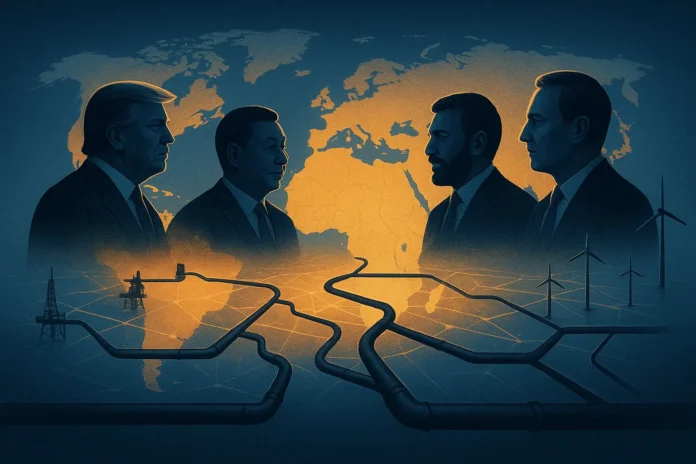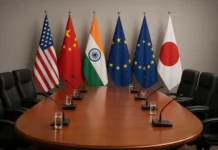In today’s interconnected world, energy is more than a resource — it’s a strategic weapon, an economic foundation, and a diplomatic bargaining chip. From oil pipelines to green hydrogen, energy decisions define alliances, shape conflicts, and determine the balance of global power.
The term “energy security” no longer just refers to having enough fuel; it encompasses stable access, affordability, and sustainability. And as nations race to secure their energy futures, diplomacy has evolved into a high-stakes game of strategy and influence.
The Foundation of Energy Security
Energy security revolves around three pillars — availability, affordability, and accessibility. Countries seek reliable sources that can sustain their economies without disruption.
- Availability ensures continuous supply despite global shocks.
- Affordability keeps energy prices stable to prevent economic stress.
- Accessibility involves building infrastructure and political ties that guarantee delivery.
When any of these pillars weaken, governments act fast — through trade deals, strategic reserves, or even military intervention. This makes energy policy inseparable from foreign policy.
Energy and Geopolitical Power
For over a century, control over energy resources has equated to geopolitical strength. The Middle East, Russia, and the United States have all leveraged their energy assets for global influence.
The 1973 oil crisis demonstrated this power vividly. OPEC nations restricted supply, driving global inflation and forcing Western economies into recession. Decades later, similar dynamics resurfaced during the Russia–Ukraine conflict, when Europe’s dependence on Russian gas exposed its vulnerability.
These examples highlight how energy can be used as a diplomatic tool or a weapon — shaping foreign relations, trade balances, and even national security strategies.
The Transition Challenge: Fossil Fuels to Renewables
As the world transitions toward cleaner energy, nations face a new challenge: balancing environmental commitments with energy stability.
Renewables like solar, wind, and hydropower are central to future energy systems, but they also create new dependencies. The production of solar panels, batteries, and wind turbines relies heavily on critical minerals such as lithium, cobalt, and rare earths — most of which are controlled by a few countries.
This shift means that “green energy security” is now as important as oil once was. Countries are competing not just for oil fields, but for mining rights, technology patents, and supply chain dominance in the clean energy sector.
Energy Diplomacy in Action
Energy diplomacy involves building relationships to ensure secure access to resources. It’s visible in global partnerships like:
- The U.S.–Saudi Alliance: Rooted in oil trade and mutual security interests.
- Europe’s LNG Agreements: Efforts to diversify supply away from Russia.
- China’s Belt and Road Initiative: Infrastructure investment that strengthens its energy corridors across Asia and Africa.
Each deal reflects a mix of economic strategy and geopolitical positioning. Nations are now as invested in pipelines and ports as they are in treaties and summits.
Asia’s Expanding Energy Footprint
Asia is rapidly becoming the center of global energy demand. China and India, driven by industrial growth and urbanization, now account for a significant share of global consumption. Their strategies — from China’s control of rare earths to India’s push for renewable self-reliance — show how energy is central to their foreign policies.
For instance, India’s partnerships with the UAE, Russia, and the U.S. are rooted in energy cooperation. Simultaneously, China’s investments in Africa’s oil and mining sectors extend its soft power far beyond its borders.
In short, the energy map of the future is tilting Eastward.
Energy Conflicts and Economic Leverage
Energy scarcity or disruption often sparks conflict — or at least diplomatic tension. Control over resources like the South China Sea’s reserves or Arctic oil fields continues to generate disputes.
Moreover, energy exporters can exert economic leverage over importers. Russia’s natural gas diplomacy in Europe and OPEC’s production cuts exemplify how controlling supply can reshape markets — and political alignments.
This dynamic creates a fragile balance where national interests, economic goals, and environmental policies often collide.
Climate Change and the New Energy Order
The global climate agenda adds another layer of complexity to energy diplomacy. Nations are under pressure to reduce emissions while maintaining economic growth. The Paris Agreement and COP summits have transformed energy from a national concern into a global diplomatic agenda.
Developed nations now negotiate not only over oil barrels but also over carbon credits, green technology transfers, and renewable financing. Energy diplomacy is thus expanding into climate diplomacy — where clean energy cooperation defines credibility and global leadership.
The Role of Strategic Reserves
One lesser-discussed but crucial element of energy security is the strategic petroleum reserve (SPR). These reserves act as an emergency buffer during supply disruptions — like wars, sanctions, or natural disasters.
For example, when oil prices spiked after the Ukraine conflict, the U.S. and its allies released millions of barrels from their reserves, stabilizing markets temporarily. This act showcased how energy management and diplomacy intertwine even during crises.
Technology’s Role in Energy Independence
Digital transformation is also redefining energy diplomacy. AI-driven grid management, blockchain-based energy trading, and smart infrastructure make it possible for countries to optimize supply chains and reduce dependency.
However, this technological revolution raises new questions — who controls the data, the algorithms, and the technology patents? As nations digitalize their energy systems, cybersecurity and tech sovereignty become integral to energy policy.
Conclusion
Energy security has become the invisible thread that ties together the world’s diplomatic, economic, and environmental agendas. It dictates alliances, influences wars, and fuels both prosperity and conflict.
In an era defined by climate urgency and geopolitical competition, nations must navigate a delicate balance — securing their energy future while cooperating on global sustainability. The world’s next great power struggles may not be fought over territory or ideology, but over who controls the energy lifelines of tomorrow.






